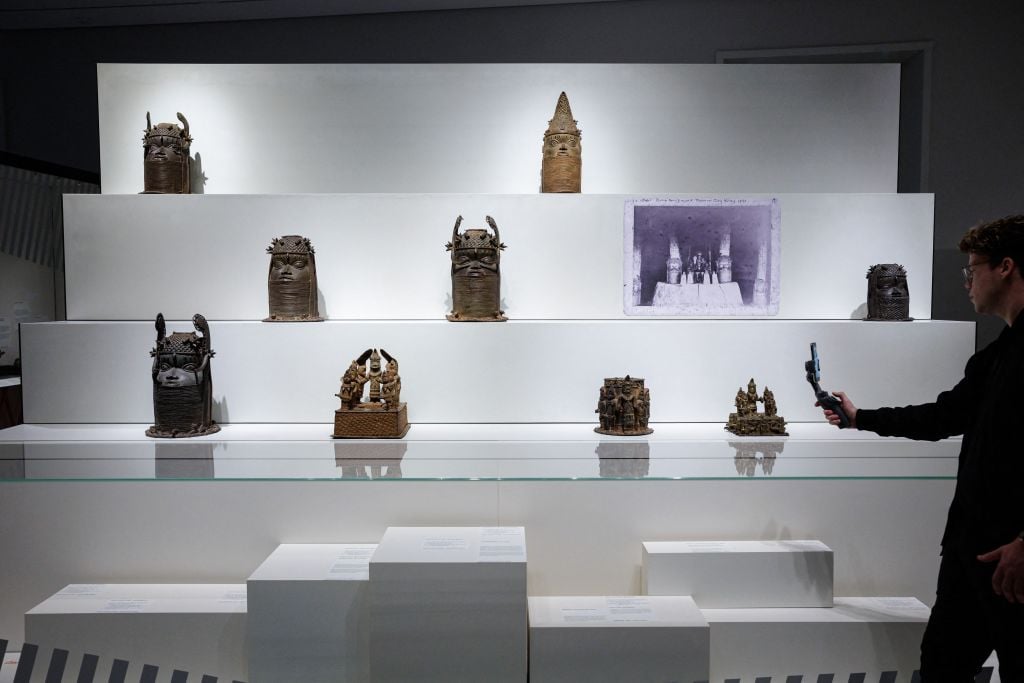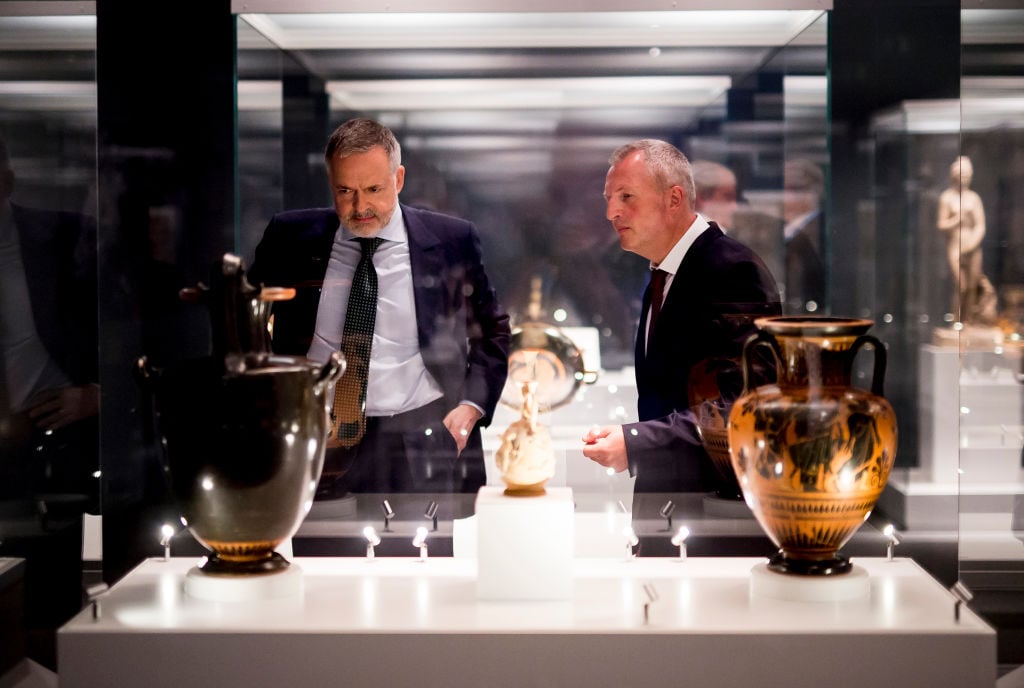Greece’s culture minister Lina Mendoni wrote a blistering commentary in response to the ongoing scandal at the British Museum, where it has come to light that more than 1,500 items from the collection were stolen by a staff member.
“The thefts by the responsible curator, but also the proud silence of the leaders who neither take care of their collections nor implement the appropriate security measures, proves that the ‘hospitality’ provided to the Parthenon marbles at the British Museum has always been flawed, incomplete, and problematic,” she stated in opinion piece for Ta Nea.
Mendoni is not alone in weaving the scandal that erupted mid-August into a renewed call for the repatriation of her country’s cultural heritage; Nigeria, China, and Wales have followed suit. Critical to her claim, is Mendoni’s focus not on one suspected lone ranger’s greedy opportunism, but on the systemic failures that allowed him to get away with it in the first place. Many of the missing items were not logged in the British Museum’s collection database.
That perhaps half of the British Museum’s mammoth collection of some 8 million objects was never fully catalogued has become a matter of keen public interest. Incomplete or out-of-date records is an issue that affects many major museums worldwide. To take just one other example, Germany’s Ethnological Museum in Berlin, housed at the Humboldt Forum, admits that “only a small number” of the 75,000 items in the collection stemming from Africa “is well documented.” Jeopardizing not only the safety of their collections but also the public’s right to access its cultural heritage and the ability of other countries to make repatriation claims.
“The ‘guarding’ of the sculptures in the British Museum has proven to be disastrous and dangerous. The urgent need for their reunion, in Athens, is now an act of justice,” continued the Greek minister.
Last week, the British Museum’s former director Hartwig Fischer resigned with immediate effect and deputy director Jonathan Williams “stepped back.” An interim deputy director and director have since been named and an independent security review has been launched by the museum.
While the investigation into the theft is still ongoing, what is known already about it points to major flaws in the ways that museums are running their collections—namely, a lack of information about collections and accountability from collections is a problem that has been on many experts’ radars for years. “It’s very important that we get away from a cozy world of museum curators choosing to share information with each other, and it being available for anyone who has an interest in the matter,” noted Barnaby Phillips, the author of Loot: Britain and the Benin Bronzes.

The Reading Room in the Great Court of the British Museum, in Bloomsbury, London, England, February 1968. Photo by Peter King/Fox Photos/Hulton Archive/Getty Images.
Who’s Counting?
Though the British Museum’s collection, it now seems, had been freely plundered for years, most of the objects taken had not been properly documented. “It’s chaos down here,” was the infamous admission from the museum’s Greek antiquities curator Peter Higgs, speaking to The Times in 2002. Earlier this year, Higgs was fired over the thefts, though he has denied any wrongdoing.
The British Museum missed its chance to appropriately crack down on the thefts in early 2021, when dealer Ittai Gradel alerted the museum about suspicious artifacts that were appearing on eBay. Though his suspicions were first aroused by Higgs’ eBay account in 2016, it would take Gradel years to amass enough evidence to approach the museum. Why? Of the 70 items that he personally bought and many more that he observed over the years, only three were listed on the British Museum’s website and could therefore be proven to have been stolen.
Inadequate funding and the funnelling of energy and expertise into blockbuster exhibitions at the expense of drearier custodial duties have been cited by experts like Dan Hicks as the primary reasons for the failure to properly record objects in the collection. On the social media platform X, the art theft expert and author Anthony Amore estimated that, practically speaking, even bountiful resources and the best of intentions may not be enough when it comes to diligent cataloguing.
“If it takes just one hour to identify, handle, photograph, and digitize a collection piece for cataloguing, and you have 8 million pieces, it would take a team of four 685 years to complete the catalogue if they work non-stop, eight hours a days, seven days per week,” he wrote.
Of course, the length of time needed to catalogue varies according to the method and object in question, and some experts noted that one hour per item may be a conservative estimate.
“I’m not excusing the British Museum, but my goal is to give context when people sit aghast that the collection wasn’t photographed,” Amore told Artnet News. “Every museum struggles with accomplishing what is considered cataloguing in 2023.”
Even in an ideal world, where a team of cataloguers are recruited by the British Museum, Amore’s calculation reveals the scale of the challenge for a collection of its size. A real solution may be more radical. “That concentration of resources in a single place is not only totally impractical, it’s totally unethical,” said Marlowe. “A new director could start a semi-permanent long-term loan initiative where the collections are distributed more evenly across the country and, ideally, across the world. To redistribute wealth, and also to distribute the burden of cataloguing.”

Sculptures known as the ‘Benin Bronzes’ are on display during a press preview of the new exhibition halls ahead of their opening at the new Berlin Palace Humboldt Forum in Berlin on September 15, 2022. Photo by Jens Schlueter/AFP via Getty Images
A Crisis of Unknowing
The theft at the British Museum also highlights issues around the digitization of collections. Many of the pieces of gold jewellery, gems, and antiquities that have gone missing were bequeathed by the antiquities collector Charles Townley in 1814. Even if they had been immediately recorded in a ledger, this would have needed to be converted onto card catalogues and, eventually, a computer database.
The problem is not uncommon. At the Museum of Fine Arts in Boston, which has a collection of nearly 500,000 items from a wide range of cultures that date from antiquity to today, provenance and archiving is a laborious and pain-staking process. “We are working with the legacy of our forebears. Even if objects have all been registered in the past, the process of making them available digitally today is not simple,” MFA Boston’s curator for provenance Victoria Reed told Artnet News.
Objects might need to be re-photographed or documented for the first time, fact-checking needs to be done on all the information provided about it as small details, from the dimensions to the medium, could be wrong; after that, one must undertake provenance and exhibition history research, in addition to building a bibliography. “Essentially, cataloguing work is never done and is never going to be perfect,” she said.
For its part, the British Museum has made attempts to modernize its storage and security systems, including a new £64 million ($81 million) facility that was first announced in 2019 and is still under construction. But does it simply own more inventory than it can manage? “The fact remains that those items would still have to be catalogued by somebody somewhere,” said Amore. “You could donate the pieces to a university, but where are they going to get the resources?”
According to Amore, catalogued items generally remain in storage, which is only accessible with an ID card and surveyed by CCTV. It is only feasible to audit a small slice of the collection at any one time, so each item can easily become a needle in a haystack. Is it all that shocking that this state of affairs is sometimes exploited? “It goes unreported, of course,” said Amore. “I know art thieves who have stolen from museum storage and you’ll never find the story in the press.”
Theft aside, when works languish in crates for centuries they may drop off the radar of both the public and the museum. It becomes impossible to monitor their conservation status. “You can’t repatriate what you don’t know you have,” said Elizabeth Marlowe, director of Museum Studies at Colgate University, in Hamilton, New York. “I don’t think it requires too much of a conspiracy-minded way of thinking to wonder if it isn’t an accident that the British Museum has catalogued less than half of their holdings.”
Many are quick to applaud high profile restitution cases when they make headlines, but it is less exciting to think about the mechanics that make these kinds of claims feasible. One publicized effort to address the issue is the project Digital Benin, the first comprehensive online catalogue of the Benin bronzes.
Phillips, the author, said the site has helped Nigeria establish and deal with restitution claims. “It should be said in fairness that the British Museum has been a dedicated and cooperative partner,” Phillips noted. Although curators from Nigeria had already been visiting the British Museum’s stores for years, the online record also provides “wider public accountability,” he added.
Despite showing willingness to participate, “on the question of restitution, the British Museum has been increasingly isolated in recent years,” said Phillips, referring to the return of many bronzes from museums in Germany and the U.S. “The British Museum has been out of step with those changes and will struggle now to justify why, when its own reputation has been damaged.”
Though this scandal may pile more pressure on the museum, there is no quick fix to the ongoing negotiations around repatriation. For one, the British Museum is currently barred by a 1963 law from deaccessioning its holdings, and for another, “Nigerian museums have problems, and those won’t be solved by how good or bad the British Museum is.”
William Carruthers, a lecturer in Heritage Studies at the University of Essex, fears a missed opportunity in the crisis where museums focus on security alone, instead of repatriation. “Security is important, but museums need to do the work to understand the multiple histories of these objects, where they came from, how they hold meaning for the people from whom they were often taken, and who should decide what now happens to them,” he said. “Whether the very limited resources available are sent in that direction is another matter.”
More Trending Stories:
U.K. Authorities Are Ready to Charge Seven Suspects Over the 2019 Theft of Maurizio Cattelan’s Gold Toilet Sculpture
China Joins a Growing Number of Nations Demanding the British Museum Restitute Artifacts From Its Collection in the Wake of Widespread Thefts
Banksy’s Blockbuster Show in Glasgow Attracted Record Crowds—and the Artist Wants You to Decide Where It Should Travel Next
Here’s How Much Money U.S. Museum Directors Make—But a Growing Backlash Could Soon Change That
For the Right Price, Guests at a Luxury Retreat in Egypt Can Help Archaeologists Dig for Cleopatra’s Long-Lost Tomb
An 1837 Portrait of an Enslaved Child, Obscured by Overpainting for a Century, Has Been Restored and Acquired by the Met
New Court Filings Show the Magnitude of Claims Being Made Against Disgraced Art Advisor Lisa Schiff
Outgoing British Museum Director Hartwig Fischer Speaks Out for the First Time About the Thefts That Took Place Under His Watch











